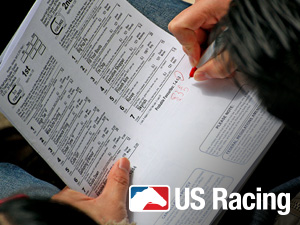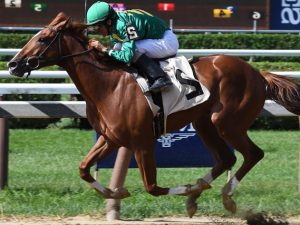By Ray Wallin
 Have you ever rolled the dice and eaten that yogurt you found in the back of your refrigerator that had a best by date of six weeks ago? It kick started your weight loss goal since you were praying to the porcelain god for three days straight.
Have you ever rolled the dice and eaten that yogurt you found in the back of your refrigerator that had a best by date of six weeks ago? It kick started your weight loss goal since you were praying to the porcelain god for three days straight.
Everywhere you go there are red flags that let you know that something may be a bad idea. The same holds true in handicapping. There are many factors that raise the red flag that a horse may not be a solid contender today.
#1 The Huge Drop
We’ve all seen this horse. You scan his past performances and see a steady string of N2X allowance races where he was competitive followed by a couple of minor stakes appearances. Yet today finds our horse as the 3-5 favorite in a $7,500 claiming race. Should you be concerned?
Why the big drop? Is the horse sound? Is the owner looking to unload him or for some quick cash hoping for someone to claim him?
Sometimes they win for fun, sometimes they don’t. Either way, tread lightly with this one.
#2 The Ultimate Equipment Change
Previously, I wrote about using negative factors to improve your handicapping. One factor that has proven to be a losing one is when a horse comes back as a first-time gelding. While there are issues with how this is reported, or not reported, from track to track, it has continued to perform much lower than the odds on the horses would suggest.
As you can see in the table above, based on a recent sample set of first-time geldings, they underperform the expected win percentage by about 6.5 percent. What is even more surprising is that when you consider horses that had morning line odds of the median 6-1 or lower, they only won at a 7.14 percent clip in 28 races and horses that were 4-1 or lower were winless in 18 starts.
While these horses are not a complete toss from your contenders list, I wouldn’t key them the last leg of your Pick 6.
#3 The L-O-N-G Layoff
All horses need a break. Some horses and trainers excel with horses that are first off the layoff. Often, you’ll see a horse that had a six-month layoff come back strong. Those layoffs don’t faze me. Even a year long layoff can be rationally explained, however when I see a horse coming back after a 16-month layoff or longer I get concerned.
The extended rest can be for any number of reasons. Sometimes a mare is meant to be bred and it doesn’t work out. Sometimes a horse needs the time to recover from an injury and setbacks during training.
If the horse last raced during the Obama administration it is likely a good idea to pass on this one today.
#4 Old Maid(en)
First time starters and maidens with a limited number of races can be difficult fields to handicap. Normally I expect that 2-year-olds and 3-year-olds can improve in subsequent starts. After all they are still developing and maturing. When you see a 6-year-old maiden, the horse has matured and isn’t likely to get any better. Either the fact that they are debuting at the age that many horses are being retired or are still struggling to try to break their maiden after a few years is a definite red flag.
Some keep running since they are consistently finishing in the money are still cashing checks to cover their expenses, but generally these horses are not a good bet, even if they look to have the best speed figures or other figures in the field.
#5 Bad Jockey Switch

Code of Honor- Photo Courtesy of NYRA
Some people will argue that the 110-pound person on the back of half ton animal doesn’t make much of a difference. Others will argue that some jockeys can work magic and make a mediocre horse run beyond his abilities.
Either way, when you see your horse lose the top jockey of the meet to another mount you should at least wonder why. If the switch from Larry the Leader was to John the Journeyman you might not give it a second thought since John the Journeyman is pretty consistent and reliable. Yet when you see Ollie the O-fer take the mount the red flag should go up since this guy hasn’t won a race since Bush was the president.
Regardless of your opinion of the value of a jockey, the fact is that good jockeys win races that lesser jockeys wouldn’t. There is a reason that Larry the Leader wins 30 percent of his races and Ollie the O-fer doesn’t win much at all.
#6 Doesn’t Look Like a Winner
In the past I have talked about looking at the physical aspects of a horse in the paddock. Even our friend Rail Guy knows when a horse looks like he wants to run or wants to go back for a second helping of hay. Signals from the eyes, ears, tail, head, their gait, or how much the horse is sweating are all indicators of how the horse is likely to run today regardless of how good they look on paper.
Admittedly it is hard to assess a horse from a simulcast monitor so this one is hard to employ when you are not on track. Yet if you can tolerate Rail Guy for a few minutes between each race, you can preserve or grow your bankroll.
Every race is different. That is what makes handicapping both fun and frustrating at the same time. So, whether you are a casual horseplayer or you make your living playing the races, it is important to identify and watch out for these handicapping red flags. What are some of the red flags that you look out for?

Ray Wallin is a licensed civil engineer and part-time handicapper who has had a presence on the Web since 2000 for various sports and horse racing websites and through his personal blog. Introduced to the sport over the course of a misspent teenage summer at Monmouth Park by his Uncle Dutch, a professional gambler, he quickly fell in love with racing and has been handicapping for over 25 years.
Ray’s background in engineering, along with his meticulous nature and fascination with numbers, parlay into his ability to analyze data; keep records; notice emerging trends; and find new handicapping angles and figures. While specializing in thoroughbred racing, Ray also handicaps harness racing, Quarter Horse racing, baseball, football, hockey, and has been rumored to have calculated the speed and pace ratings on two squirrels running through his backyard.
Ray likes focusing on pace and angle plays while finding the middle ground between the art and science of handicapping. When he is not crunching numbers, Ray enjoys spending time with his family, cheering on his alma mater (Rutgers University), fishing, and playing golf.
Ray’s blog, which focuses on his quest to make it to the NHC Finals while trying to improve his handicapping abilities can be found at www.jerseycapper.blogspot.com Ray can also be found on Twitter (@rayw76) and can be reached via email at ray.wallin@live.com.


